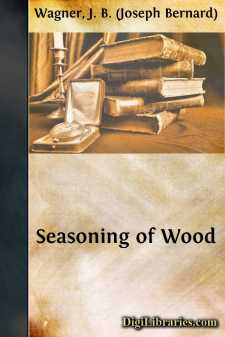Categories
- Antiques & Collectibles 13
- Architecture 36
- Art 48
- Bibles 22
- Biography & Autobiography 813
- Body, Mind & Spirit 142
- Business & Economics 28
- Children's Books 15
- Children's Fiction 12
- Computers 4
- Cooking 94
- Crafts & Hobbies 4
- Drama 346
- Education 46
- Family & Relationships 57
- Fiction 11829
- Games 19
- Gardening 17
- Health & Fitness 34
- History 1377
- House & Home 1
- Humor 147
- Juvenile Fiction 1873
- Juvenile Nonfiction 202
- Language Arts & Disciplines 88
- Law 16
- Literary Collections 686
- Literary Criticism 179
- Mathematics 13
- Medical 41
- Music 40
- Nature 179
- Non-Classifiable 1768
- Performing Arts 7
- Periodicals 1453
- Philosophy 64
- Photography 2
- Poetry 896
- Political Science 203
- Psychology 42
- Reference 154
- Religion 513
- Science 126
- Self-Help 84
- Social Science 81
- Sports & Recreation 34
- Study Aids 3
- Technology & Engineering 59
- Transportation 23
- Travel 463
- True Crime 29
Seasoning of Wood
Categories:
Description:
Excerpt
SECTION I
TIMBER
Characteristics and Properties
Timber was probably one of the earliest, if not the earliest, of materials used by man for constructional purposes. With it he built for himself a shelter from the elements; it provided him with fuel and oft-times food, and the tree cut down and let across a stream formed the first bridge. From it, too, he made his "dug-out" to travel along and across the rivers of the district in which he dwelt; so on down through the ages, for shipbuilding and constructive purposes, timber has continued to our own time to be one of the most largely used of nature's products.
Although wood has been in use so long and so universally, there still exists a remarkable lack of knowledge regarding its nature, not only among ordinary workmen, but among those who might be expected to know its properties. Consequently it is often used in a faulty and wasteful manner. Experience has been almost the only teacher, and theories—sometimes right, sometimes wrong—rather than well substantiated facts, lead the workman.
One reason for this imperfect knowledge lies in the fact that wood is not a homogeneous material, but a complicated structure, and so variable, that one piece will behave very differently from another, although cut from the same tree. Not only does the wood of one species differ from that of another, but the butt cut differs from that of the top log, the heartwood from the sapwood; the wood of quickly-grown sapling of the abandoned field, from that of the slowly-grown, old monarch of the forest. Even the manner in which the tree was cut and kept influences its behavior and quality. It is therefore extremely difficult to study the material for the purpose of establishing general laws.
The experienced woodsman will look for straight-grained, long-fibred woods, with the absence of disturbing resinous and coloring matter, knots, etc., and will quickly distinguish the more porous red or black oaks from the less porous white species, Quercus alba. That the inspection should have regard to defects and unhealthy conditions (often indicated by color) goes without saying, and such inspection is usually practised. That knots, even the smallest, are defects, which for some uses condemn the material entirely, need hardly be mentioned. But that "season-checks," even those that have closed by subsequent shrinkage, remain elements of weakness is not so readily appreciated; yet there cannot be any doubt of this, since these, the intimate connections of the wood fibres, when once interrupted are never reestablished.
Careful woods-foremen and manufacturers, therefore, are concerned as to the manner in which their timber is treated after the felling, for, according to the more or less careful seasoning of it, the season checks—not altogether avoidable—are more or less abundant.
There is no country where wood is more lavishly used or criminally neglected than in the United States, and none in which nature has more bountifully provided for all reasonable requirements.
In the absence of proper efforts to secure reproduction, the most valuable kinds are rapidly being decimated, and the necessity of a more rational and careful use of what remains is clearly apparent. By greater care in selection, however, not only will the duration of the supply be extended, but more satisfactory results will accrue from its practice.
There are few more extensive and wide-reaching subjects on which to treat than timber, which in this book refers to dead timber—the timber of commerce—as distinct from the living tree. Such a great number of different kinds of wood are now being brought from various parts of the world, so many new kinds are continually being added, and the subject is more difficult to explain because timber of practically the same character which comes from different localities goes under different names, that if one were always to adhere to the botanical name there would be less confusion, although even botanists differ in some cases as to names. Except in the cases of the older and better known timbers, one rarely takes up two books dealing with timber and finds the botanical names the same; moreover, trees of the same species may produce a much poorer quality of timber when obtained from different localities in the same country, so that botanical knowledge will not always allow us to dispense with other tests.
The structure of wood affords the only reliable means of distinguishing the different kinds....


